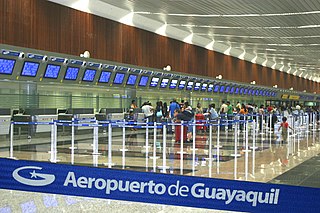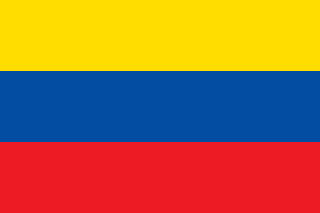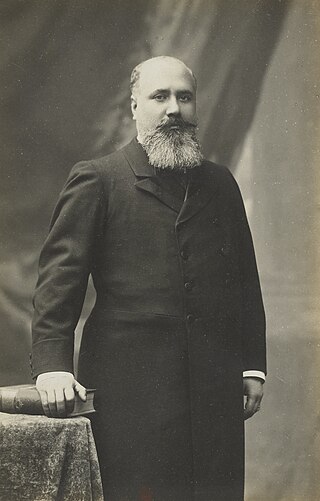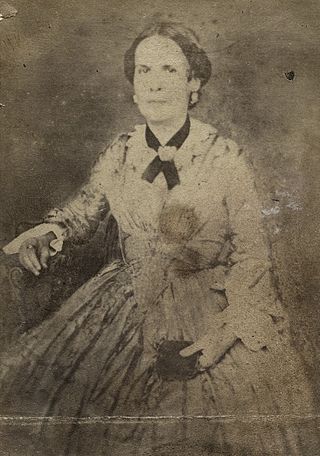Ana Villamil Icaza was born in Guayaquil, Ecuador (January 19, 1852) and died in Guayaquil, Ecuador (October 23, 1916). She was a composer, artist and a teacher of piano and singing.
Ana Villamil Icaza was born in Guayaquil, Ecuador (January 19, 1852) and died in Guayaquil, Ecuador (October 23, 1916). She was a composer, artist and a teacher of piano and singing.
Ana was born to her father was Francisco Villamil y Garaicoa, and mother Isabel María Icaiza y Paredes.[ citation needed ]Her father was the son of José de Villamil, an Ecuadorian Independence leader. Her mother Isabel was the daughter of Francisco de Paula Icaza and Isabel Paredes y Olmedo; niece of the poet Magdalena, and sister of José Joaquin de Olmedo. [1]
Ana worked as music teacher at municipal schools in her hometown throughout her life. [2] She lived in Guayaquil at "10 de Agosto and Chimborazo," which is now considered to be a historic site. She lived there until her death on October 23, 1916. [3]
Inspired by José Joaquin de Olmedo, she composed the music to "The hymn of Guayaquil," which was later recognized as The Guayaquil anthem. [4]

Guayaquil, officially Santiago de Guayaquil, is the largest city in Ecuador and also the nation's economic capital and main port. The city is the capital of Guayas Province and the seat of Guayaquil Canton. The city is located on the west bank of the Guayas River, which flows into the Pacific Ocean at the Gulf of Guayaquil.

José Joaquín de Olmedo International Airport is an international airport serving Guayaquil, the capital of the Guayas Province and the most populous city in Ecuador. It is the second busiest airport in Ecuador.

The March Revolution or Revolution of Forty-Five began on 6 March 1845, when the people of Guayaquil under the leadership of General António Elizalde and Lieutenant-Colonel Fernándo Ayarza revolted against the government of Juan José Flores. The people took the artillery barracks of Guayaquil along with other military and civilian supporters, including the guard on duty. Flores surrendered on his plantation, La Elvira, near Babahoyo and accepted a negotiation - which had terms including his leaving power and the declaration of all his decrees, laws, and acts as void and null, ending fifteen years of foreign domination in Ecuador. Flores received 20,000 pesos for his property and immediately left the country for Spain. The country was then governed by the triumvirate composed of José Joaquín de Olmedo, Vicente Ramón Roca and Diego Noboa.

José Joaquín de Olmedo y Maruri was President of Ecuador from 6 March 1845 to 8 December 1845. A patriot and poet, he was the son of the Spanish Captain Don Miguel de Olmedo y Troyano and the Guayaquilean Ana Francisca de Maruri y Salavarría.

José de Villamil or José Villamil (1789–1866) was born in New Orleans, when Louisiana was a colony of Spain. He was one of the fathers of the independence of Ecuador, founder of its navy, "conqueror" and first Governor of the Galápagos Islands and Minister of Foreign Relations. The city of General Villamil Playas is named in honor of him. José de Villamil was the younger brother of Felipe Martin de Villamil (1783–1843).

The Ecuadorian–Peruvian War took place between 1857 and 1860. The conflict began when Ecuador attempted to sell Amazon basin land claimed by Peru in order to settle a debt with British creditors. When diplomatic relations between the two countries broke down, prior to the fragmentation of the Ecuadorian government into several competing factions, the Peruvian government ordered a blockade of Ecuador's ports in order to force the cancellation of the sale, and the official acknowledgement of Peruvian ownership of the disputed territories. By late 1859, control of Ecuador was consolidated between General Guillermo Franco, in the city of Guayaquil, and a provisional government in Quito headed by Gabriel García Moreno. Peruvian President Ramón Castilla sailed to Guayaquil with several thousand soldiers in October 1859, and negotiated the Treaty of Mapasingue with General Franco in January 1860. The signing of the treaty indicated Ecuadorian compliance with all of Peru's demands, and temporarily marked the end of the territorial dispute between the two countries. However, in September 1860, the forces of the provisional government, commanded by García Moreno and General Juan José Flores defeated Franco's government at the Battle of Guayaquil, ending the civil war in Ecuador. The new government disavowed the Treaty of Mapasingue, followed shortly afterwards by its Peruvian counterpart; this re-opened the territorial dispute.

Canción al 9 de Octubre is a poem written by José Joaquín de Olmedo in 1821, to commemorate the 1820 Independence of Guayaquil. A mayoral decree on July 8, 1898 officially declared it as "Himno al 9 de Octubre", and this Anthem in honor of Guayaquil's Independence became widely known as Guayaquil's Anthem.

The history of the Republic of Ecuador from 1830 to 1860 begins with the collapse of the nation of Gran Colombia in 1830, followed by the assassination of Antonio José de Sucre and the death of Simón Bolívar from tuberculosis the same year. Heartbroken at the dissolution of Gran Colombia, Bolívar is quoted to have said shortly before his death, "America is ungovernable. Those who have served the revolution have plowed the sea." These words would seem prophetic during the chaotic first thirty years in the existence of Ecuador.

Nela Martínez Espinosa was an Ecuadorian communist, political militant, activist, and writer.

Víctor Manuel Rendón Pérez was an Ecuadorian writer, poet, novelist, playwright, biographer, translator, doctor, diplomat, pianist and composer.

Carmen Acevedo Vega was an Ecuadorian poet, writer, and journalist.

Rosa Borja Febres-Cordero known as Rosa Borja de Ycaza was an Ecuadorian writer, essayist, dramatist, sociologist, poet, novelist, feminist and activist.

Teresa Josefa Jado y Urbina was the First Lady of Ecuador from 1852 to 1856 as the wife of President José María Urbina.

The flag of Guayaquil was established after the victory of the emancipatory troops in the independence of the city on October 9, 1820 as the insignia of the Free Province of Guayaquil that encompassed several provinces of the current Ecuadorian coast. It is maintained that it was José Joaquín de Olmedo who devised the sky blue and white pavilion, being himself the one who designed the current coat of arms of the city. The flag is divided into 5 horizontal stripes, 3 of them sky blue and the other 2 white. In addition in the central sky blue fringe there are 3 white stars.

Josefa Baltazara Calderón Garaycoa, also known by her married name of Baltazara Calderón de Rocafuerte, was an Ecuadorian philanthropist, the wife of the second president of Ecuador, Vicente Rocafuerte, and sister of Abdón Calderón.
María Alejandra Paredes Orejuela is an Ecuadorian actress. She is best known for her character Penélope de la Cruz on the TV series La pareja feliz.

The Free Province of Guayaquil was a South American state that emerged between 1820 and 1822 with the independence of the province of Guayaquil from the Spanish monarchy. The free province had a provisional government and constitution until its annexation by Gran Colombia in 1822. Its successor was the Department of Guayaquil forming part of Gran Colombia. The Spanish province of Guayaquil was separated from the Viceroyalty of Peru and in those days it only depended legally on the court of the Real Audiencia de Quito. About a decade later, the Departments of Guayaquil, Azuay, and Ecuador separated from Gran Colombia forming the current Ecuador.

The October 9 Revolution was a successful revolt against the Spanish Empire in Guayaquil on October 9, 1820. It was led by the General Antonio José de Sucre and directed by Simón Bolívar. The revolt established a revolutionary junta and created the Free Province of Guayaquil, an independent state. The independence of Guayaquil revived the war of independence of the Real Audiencia de Quito as part of the Spanish American wars of independence. Prominent events in the revolution include the uprising of the Spanish garrison in the city of Guayaquil and the control of the Pacific by the Liberating Expedition of Peru, under the command of José de San Martín.

The House of Luzárraga is a Spanish house of nobility whose origins date back to Basque-Navarrian nobility, and source its name to the progenitor of its most famous member, Admiral Manuel Antonio de Luzárraga y Echezuria, who would later become the governor of Guayaquil.